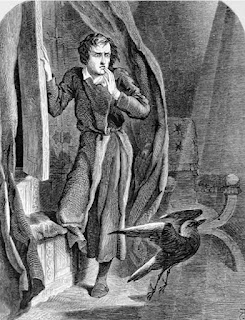"And the Raven, never flitting, still is sitting, still is sitting
On the pallid bust of Pallas just above my chamber door;
And his eyes have all the seeming of a demon's that is dreaming,
And the lamplight o'er him streaming throws his shadow on the floor;
And my soul from out that shadow that lies floating on the floor
Shall be lifted-nevermore!"
The Raven. Edgar Allen Poe 1845
Dearest Em,
In 1858, an anthology of Poems caused a sensation in London society, by Edgar Allen Poe. This dark mystical and fascinating poets work from across the pond; ( whose tales began to be read aloud at fancy Salons ), would send the heebie-jeebies to an eager audience thrilled by his powerfully gothic imagination provoking tales.
Poe who was born in 1809, married his 13 year old cousin who died, and then aged 40 had also left the World under questionable causes. In 1841 he published an essay on his particular form of 'cryptography'- a simple substitution cryptogram that his analytical mind saw 'that the public didn't see it'. He was also something of an American 'Ruskin', being dubbed 'Tomahawk Man' who regularly and roundly accused Longfellow of plagiarism.
The portrait here of Poe is clearly the muse for the Chartacter illustrated by John Tenniel in the UK publication of 'The Raven' ( worked seven years before he agreed to illustrate 'Alice' ) and Tenniel says of himself that he had the ability to meet somebody once, or be shown their portrait and that was all the preparation he needed to produce an illustration. Clever chap.
Our study, then a young impressionable Charles Dodgson in his late teens and early twenties, with a keen eye for criticism, satire and parody may well have come across 'The Raven' in 1846 when it became an instant success in America.
Upon further interest in Poe and his works, he would share Poe's interest in Cryptography, Phrenology, and himself penned a parody of a Longfellow poem 'Hiawatha's Photographing' in 1857.
The Raven itself was chosen as a 'non-reasoning creature capable of speech'. In Poe's terms this was accepted as being inspired by Dickens 'Barnaby Rudge' in which Poe felt he hadn't done proper hommage to its use.
James Russell Lowell in a 'Fable for Customs' quotes:- "Here comes Poe with his Raven, like Barnaby Rudge, Three-fifths genius, two-thirds sheer fudge. "
Enter stage-right, Lewis Carroll troubled by his own demons, writing love-poetry ( since destroyed along with some pages of his diary ) also publishing critique under a pseudonym, and obsessed with cryptography.
In 'Alice in Wonderland' at the 'Mad Tea Party' we hear 'Why is a raven like a writing desk?' posed as a riddle to Alice, who gives up. Carroll maintained that he meant this to be nonsense, however he offered up a clue years later in 1896, saying the Raven, was 'Nevar, with the wrong end in front'.
However, it would now seem pretty logical at least in the mind of Dodgson's parodic, cryptographic and satiric eye, that the 'non reasoning creature capable of speech' may indeed have sat on his writing desk.
The Raven returns triumphant in its position in 'Alice', its third time lucky...
What say you Em?
As ever, your loving Grand-mother GiGi



No comments:
Post a Comment